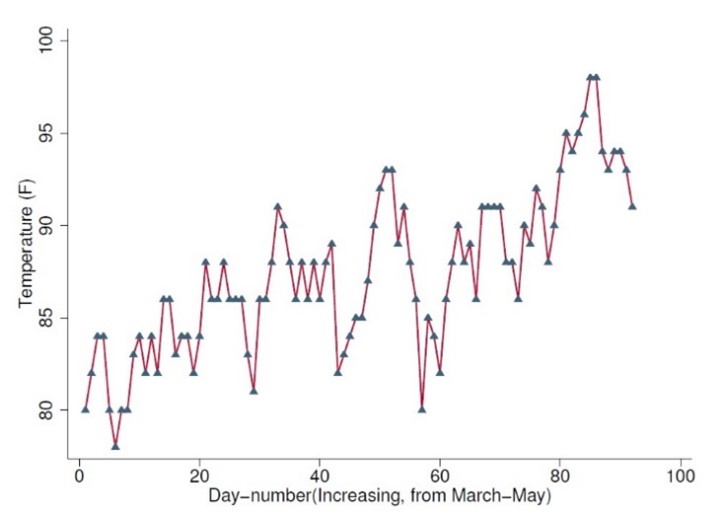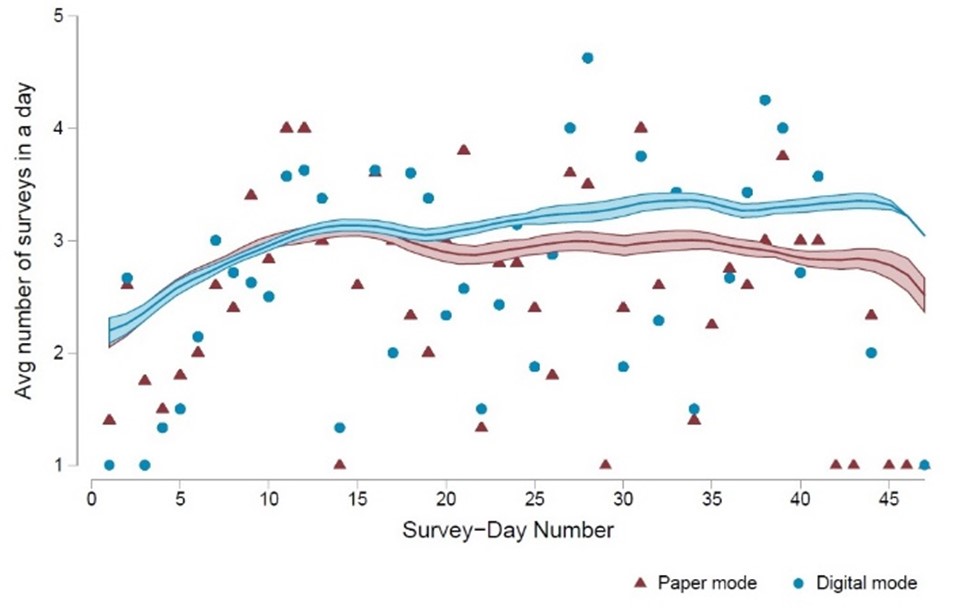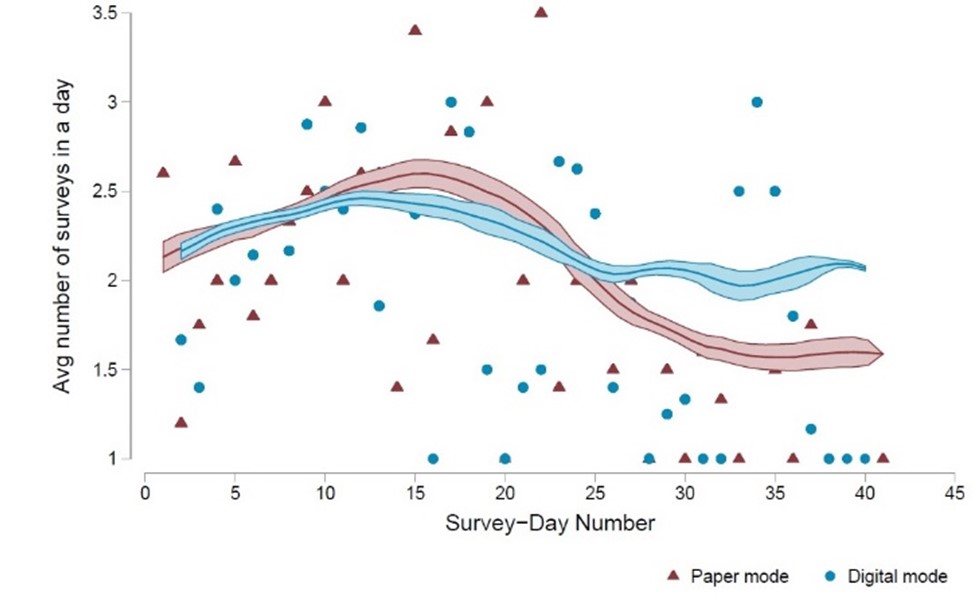World Bank
Exposure to high heat causes productivity losses, with reduction in cognitive function as a key channel. A direct reduction in heat exposure via technologies such as air conditioning is not possible for outdoor tasks. This article presents results from a randomised experiment in Odisha where the use of a digital mode – rather than the traditional pen-and-paper mode – for household surveys helped mitigate some of these heat-induced productivity losses.
Weather has an impact on human conditions, and on numerous economic outcomes. Severe weather, including high temperatures, has been shown to hurt various drivers of growth such as human survival, human capital, and worker productivity (see Deschenes and Greenstone 2007, Burgess et al. 2011, Garg et al. 2020, LoPalo 2019). While cooling technology (such as air conditioning (AC)) can mitigate some of these negative impacts, it is difficult to reduce losses in worker productivity on account of heat, when the tasks are conducted outdoors. This is a critical issue in developing countries that are characterised by a tropical climate and lack of economic resources. A tropical climate exposes workers to heat and humidity, thereby reducing their productivity, and the lack of resources makes it harder to compensate for the loss in productivity. In this article, we summarise the results of a study that analyses the role of technology in compensating for heat-induced productivity loss in India (Custers et al. 2020).
Context
The study is based on a randomised experiment conducted in Bhubaneshwar, Orissa, a city that is characterised by very hot and humid summers. Cognitive functions slow down due to exertion while exposed to high heat (see Kjellstrom et al. 2009, Garg et al. 2020, Zivin et al. 2018), which may lead to reduced productivity of a worker. The heat and humidity make outdoor tasks difficult and one such task is conducting household-level surveys. Technological advancements in the area of survey data collection – such as digital data collection – provide an opportunity to conduct the same survey but with a reduced cognitive load. Digital surveys on devices such as phones and tablets allow for pre-coded tasks such as skipping an invalid question, restricting the responses to correct ranges, and providing a concise and compact way of conducting the survey. Compared to the classic method using pen and paper, a digital survey eliminates several potential mistakes and also makes the overall handling of the survey easier.1 These advantages make digital surveys a more productive option, wherein more surveys can be completed in the same allotted time as compared to a paper survey. While exposure to high heat reduces the productivity of a surveyor irrespective of the mode being used, surveyors using the digital mode are likely to face lower productivity loss as these surveys automate several cognitive tasks, hence reducing the productivity impact of heat.
Heat-induced productivity loss: Can digital surveys help?
We conducted an experiment where we randomly assigned a total of 15 surveyors2 with a survey mode and household to be surveyed. The surveyors were given either a digitally coded survey on an Android tablet, or a survey printed on paper to be filled in by pen. The assigned survey mode remained constant throughout the study. In both cases, the content of the survey remained the same. The time taken by each surveyor to complete each section of the survey, along with the audio of the respondent’s answers were recorded and later transcribed.
The survey was conducted during March-May 2015 with 2,000 households in urban slums in Bhubaneswar. During this period of survey activity, the average temperature in the city rose from comfortable levels like 25°C to very hot levels like 40°C and above.3 There was also substantial variation in the temperature as the survey activities were carried out from one day to the other (Figure 1). The surveyed households lived in some of the poorest pockets of the city, and hence any direct reduction in exposure to heat using a water cooler or AC is unlikely.
We combine the daily variation in temperature with the randomly assigned survey mode, to analyse the impact of the survey mode on productivity (average number of surveys completed per person-day).
Figure 1. Daily average temperatures in Bhubaneswar, March-May 2015
Leveraging the daily variation in heat, I find that when exposed to hotter days, surveyors using the digital method are more productive as compared to their counterparts who used the paper mode. The productivity difference is 5.23% (22% of one completed survey), which translates to approximately 23.5 person-days. Using data on the duration to complete each survey section, we find that digital surveys are faster, on average, and the observed productivity difference between the digital and paper modes is highest on the days that had very high temperatures.
One potential confounding factor in establishing the causal effect of heat on surveyor productivity is the variation in the effort of surveyor using the two modes. While effort is not directly observed and is hard to measure, any difference in effort is likely to show up in the quality of data collection. To test this, we use the audio transcription of all surveys and compare them to the data recorded in the surveys. We find that the digital and paper surveys generate statistically similar mismatches, that is, similar quality of data, thereby providing evidence against this potential confounding channel.
Figure 2a. Productivity differences across survey modes in the first half of workday
Figure 2b. Productivity differences across survey modes in the second half of workday
Concluding remarks
Reducing productivity losses due to extreme heat requires investment in heat-reducing technology, and this is challenging for developing countries. Additionally, heat-reducing technologies are not applicable in contexts where the tasks are primarily based outdoors (Adhvaryu et al. 2018 for use of technology to reduce indoor heat exposure). While productivity losses due to high heat cannot be mitigated by such technology, a technology that reduces the cognitive load of tasks can counter the heat-induced losses occurring due to lower cognitive function when exposed to heat. We test this hypothesis in a survey enumerator-based experiment and find that a digital survey reduces productivity losses as compared to a classic pen-paper-based method when surveyors are exposed to hot weather during workdays.
I4I is now on Telegram. Please click here (@Ideas4India) to subscribe to our channel for quick updates on our content.
Notes:
-
A survey on a digital device usually displays one question after the other and does not allow any valid questions to be skipped. It avoids certain tasks while doing a paper survey like flipping over pages or making sure (turning back to see) if a question is skipped by mistake.
- The sample size is number of surveyors x work-days. The unit is worker-days in the experiment is close to 450.
-
Apart from the dry heat, Bhubaneswar sees very high levels of relative humidity during summers. Therefore, the ‘feels like’ temperature is much higher.
Further Reading
- Adhvaryu, A, N Kala and A Nyshadham (2018), ‘The Light and the Heat: Productivity Co-benefits of Energy-saving Technology’, NBER Working Paper No. 24314.
- Custers, A, P Kasina, D Saraswat and AP Verma (2020), ‘Can Technology Mitigate the Impact of Heat on Labor Productivity? Experimental Evidence from India’, Working paper.
- Deschenes, Olivier and Michael Greenstone (2007), “The economic impacts of climate change: Evidence from agricultural output and random fluctuations in weather”, American Economic Review, 97(1): 354–385.
- Burgess, R, O Deschenes, D Donaldson and M Greenstone (2011), ‘Weather and death in India’, Massachusetts Institute of Technology, Manuscript.
- Garg, T, M Jagnani and E Lyons (2020), ‘Experimental Evidence on the Effects of Heat on High-Skilled Team Performance’, Working Paper.
- Garg, Teevrat, Maulik Jagnani and Vis Taraz (2020), “Temperature and Human Capital in India”, Journal of the Association of Environmental and Resource Economists, 7(6): 1113–1150.
- Kjellstrom, Tord, Ingvar Holmer and Bruno Lemke (2009), “Workplace heat stress, health and productivity–an increasing challenge for low and middle-income countries during climate change”, Global Health Action, 2: 10.3402.
- LoPalo, M (2019), ‘Temperature, Worker Productivity, and Adaptation: Evidence from Survey Data Production’, Working Paper.
- Zivin, Joshua Graff, Solomon M Hsiang and Matthew Neidell (2018), “Temperature and Human Capital in the Short and Long Run”, Journal of the Association of Environmental and Resource Economists, 5(1): 77-105.
Social media is bold.
Social media is young.
Social media raises questions.
Social media is not satisfied with an answer.
Social media looks at the big picture.
Social media is interested in every detail.
social media is curious.
Social media is free.
Social media is irreplaceable.
But never irrelevant.
Social media is you.
(With input from news agency language)
If you like this story, share it with a friend!
We are a non-profit organization. Help us financially to keep our journalism free from government and corporate pressure




















0 Comments